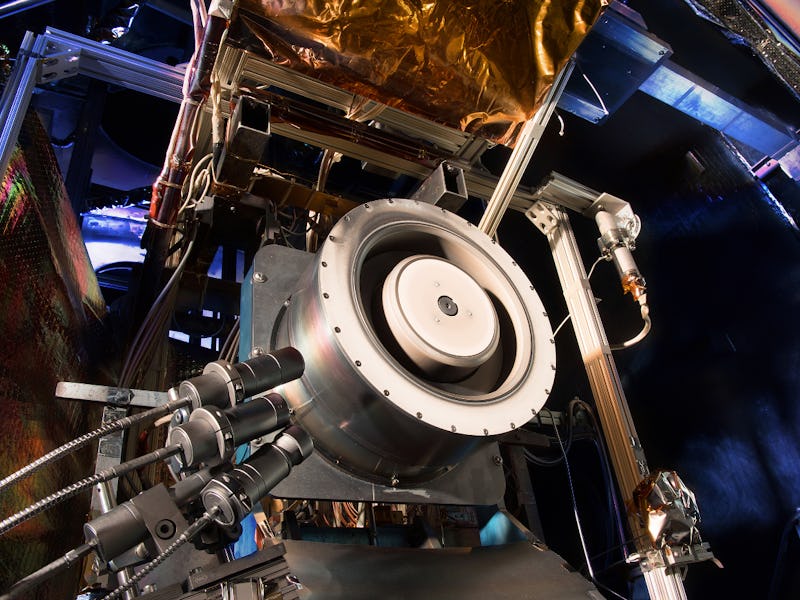NASA Will Test a Solar Electric Propulsion System on the Asteroid Redirect Mission
The space agency is pushing for new ways to get spacecraft around the solar system efficiently, and make deep space exploration possible.

One of the top three impediments to deep space exploration is finding a propulsion system that can get us to the far reaches of space both faster and while using less non-renewable resources. Some ideas like the EmDrive (which uses ambient microwave energy as a propellant, not fuel) would irrevocably transform modern space travel – but its leap from mythology to reality is in doubt. This week, NASA did, however, give a serious nod to another renewable-energy space propulsion technology, making it look a lot more like a realistic option.
On Tuesday, the government space agency awarded a $67 million contract to Aerojet Rocketdyne, Inc to design a Solar electric propulsion (SEP) system for deep space exploration. Though an SEP system wouldn’t get us to places faster, it would help us jettison fuel from spacecraft in favor of a more sustainable, cost-effective system. NASA officials spoke to reporters during a teleconference on Thursday to expound on the contract’s details behind its new technology deal and how it expects Aerojet’s work to impact future missions down the road.
Among the major points raised was that NASA considers SEP to be “a perfect example of a cross-cutting technology,” said Steve Jurczyk, associate administrator of NASA’s Space Technology Mission Directorate. The agency’s Glenn Research Center has been working on SEP since the ‘50s, with the goal of displacing the need for propellant in any kind of NASA mission. This includes sending robots to far-flung worlds, aiding crewed or uncrewed spacecraft en route to Mars to carry more cargo, and allowing commercial spaceflight companies the ability to move between Earthbound orbits faster and more efficiently.
The contract calls for a system that combines and alternates between electric power and a chemical-based system. Although an SEP system would free up space onboard a craft and be more sustainable, it simply doesn’t generate the thruster power that a chemical system still allows for.
Aerojet’s design, at 50-kilowatts, would not be a single, gigantic thruster — but rather what Bryan Smith at the Glenn Research Center calls “building blocks” which strings together parts of the system as it suits the mission. For example, an orbital mission close to Earth could probably do fine with a propulsion system that was primarily running on SEP, while missions further out — like a resupply of colonists on Mars – would want to retain the speedier capabilities provided by a chemical system.
It’s more of an “evolution of previous SEP technology” than a brand new system, said Jurczyk. If all goes well, Aerojet’s new propulsion technology would allow most spacecraft to have a propulsion capability “almost two times greater than what is being flown today,” said Smith. He considers this to be a new drivetrain “that enables whole new platforms for deep space exploration.”
The biggest takeaway from the teleconference was confirmation that Aerojet’s system would be tested on NASA’s upcoming Asteroid Redirect Mission (ARM), which will send a robotic spacecraft to a near-Earth asteroid, pick up a large boulder, and carry it to the moon to drop it in lunar orbit for human astronauts to study. The 50-kw design was focused around the needs of such a mission.
Of course, exactly when or how, or even why, that mission is happening is still up in the air.
According to Jurczyk, NASA is “still in pre-formulation for ARM — [for] both the robotic part, and the human part.” The agency is still doing spacecraft study contracts to figure out what exactly they want to build, and Aerojet’s contract will encompass the propulsion being used on that mission. So far, there is a 2025-2026 time frame for getting the asteroid boulder back to lunar orbit — which means they’d want to launch around 2021 or 2022.
Perhaps most disconcerting of all, the whole mission “depends on a target asteroid,” said Jurczyk — and NASA hasn’t selected one yet.
Still, we might see Aerojet’s SEP engine being used on a mission before that. As of now, NASA is considering a Mars mission for 2022, but it’s unclear what they might do. Jurczyk suggested the agency might try to send a new orbiter to the red planet to help bolster telecommunications equipment with the rovers on the surface and with other spacecraft in the solar system.